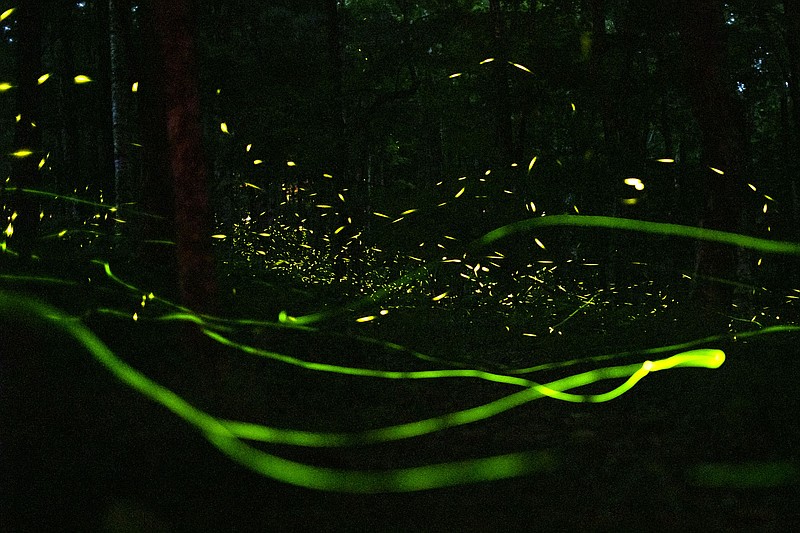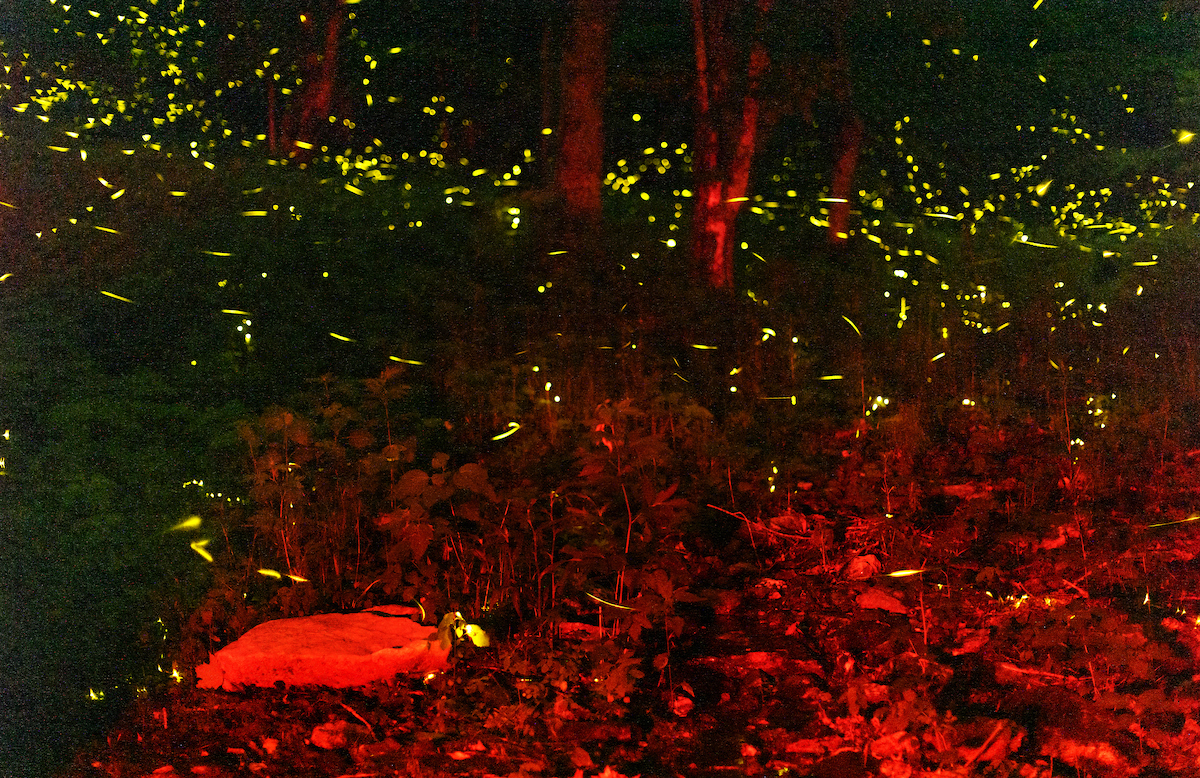As a younger man, Joe Cicero saw "thousands and thousands of them." Swarms of fireflies put on a soundless fireworks show for him every summer in southern Arizona.
The sight of the fireflies flashing in unison was so mysterious and mesmerizing that the entomologist made the study of the flickering insects his life's work.
Four decades later, Cicero, now retired, still goes back to those oak woodlands. Today, though, they're mostly dark. The fireflies (aka lightning bugs) have been decimated, Cicero lamented. "Down to just a trivial few relative to the big population they had back then."
The insects go by many names, depending on where you live. Forget what the calendar officially says. For many Americans, their otherworldly glow signals the start of summer.
But across the country, many of these harbingers of summer may be blinking out of existence. What was once a series of tales from old-timers about the decline of fireflies from the days of their youth is coalescing into a disturbing scientific truth.
Nearly 1 in 3 firefly species in the United States and Canada could be threatened with extinction, firefly experts estimate in a recent comprehensive assessment. Surveys abroad show declines from mangroves in Malaysia to grasslands in England. New research is shedding light on how these ethereal insects are struggling to thrive in the brightly lit world we have built around them.
And the problem is bigger than a single type of bug. "The fireflies are the icons that tell you that the habitat is in trouble," Cicero said.
In so many spots where scientists look, insects of all sorts are vanishing, with potentially disastrous results. Populations are plunging in Germany and the Netherlands, in Puerto Rico and the American West, leading to fears of a potential-though-still hotly debated "bugpocalypse," which could unravel food webs for birds and other insect-eating animals and cause calamity for farmers who need pollinators to grow crops.
"I know a lot of people who hate insects. I've never met a single person who didn't like fireflies," said Sara Lewis, a Tufts University biologist and author of "Silent Sparks: The Wondrous World of Fireflies."
For her, the firefly is "the gateway bug for illuminating the need to protect" the rest of the natural world.
Plight of the firefly
To understand the threats to fireflies, start underground.
Fireflies in the United States spend the vast majority of their lives in their larval state, roaming the dirt to consume snails, worms and other soft-bodied grub several times their size. In contrast to their gentle summertime image, baby fireflies are vicious predators.
But much of the swampy soil young fireflies need to thrive is increasingly being bulldozed for golf courses, suburban subdivisions and other types of development, making habitat loss a top threat.
In Delaware and Maryland, for instance, the Bethany Beach firefly delights beachgoers – or at least it used to. Today, its sandy habitat is being squeezed by beach-home construction on the one side and by sea-level rise because of climate change on the other. Now it has nowhere else to go, making it one of the country's most imperiled firefly species.
"These wetlands only occur right along the beach along the Mid-Atlantic," said Christopher Heckscher, an environmental scientist at Delaware State. "So that ends up pushing Bethany Beach firefly right to the top in terms of priority for protection."
In Arizona, the Southwest synchronous firefly that Cicero studies is being trampled by different threats. Cattle and all-terrain vehicles in Coronado National Forest are stomping out its riverside habitat, he said. "It's very damaging."
Welcome to the light show
When the time is right in the spring, juvenile fireflies seek a spot to pupate. Much like how a caterpillar transforms into a butterfly, a young firefly rearranges its body to turn into an adult. Then they take flight.
The adults live for only a few weeks – with one thing on their minds. Fireflies flicker at each other to find their mates. The spectacle is, in fact, one big bug orgy.
Some fireflies start the sexual pyrotechnics at dusk. Others wait until midnight to turn on the lights. Some wink at each other with a double flash; others a triple.
Males of certain species work together to woo mates by synchronizing their pulses. Other varieties are more ruthless, imitating the flashes of smaller fireflies to lure them in – and eat them. There are more than 2,000 species of fireflies globally, each doing a different dance.
Even in the best conditions, males drifting in the air struggle to find females on the ground. "Mating success rate in darkness is not especially high," said Avalon Owens, a research fellow at Harvard. "I have no idea how we still have fireflies when they're so bad at this. So many things can go wrong."
Increasingly, we're the ones making it harder. The artificial light we pour into the night is interrupting these bioluminescent courtships.
To test the impact of light pollution, Owens set up a mating arena on her porch in her home outside Boston in 2020 during the height of the coronavirus pandemic. "Our landlord didn't insulate it, which was perfect," said Owens, at the time a Ph.D. student under Lewis. "So it's just exposed to the elements. And I just kept the window open the whole summer."
In a study published last year, Owens and Lewis found exposing a semi-nocturnal firefly species called Photinus obscurellus to a bright light on the porch completely prevented it from mating. Out in the wild, the pair found males of a related species, P. greeni, preferred LEDs meant to imitate females that were bathed in darkness.
Brightening the night not only makes it harder for fireflies to see each other, it can also trick them into thinking it is daytime, Owens said. "It erases their habitat," she added. "It gets rid of places where they can be."
'Turn off the light'
Not every type of firefly is in peril. Some are actually thriving in our well-lighted world.
The big dipper firefly, named for the swooping arc it draws in the sky, evolved to come out at dusk and does not seem to mind modern streetlights. In their field experiments, Owens and Lewis found artificial lighting had little impact on the big dipper's mating. Plenty can be found in well-lit corners of Central Park in New York.
For many fireflies, there is a painful lack of data on even baseline populations. While some species remain abundant, overall, we risk the loss of firefly biodiversity.
Despite the threats, no firefly species is protected under the Endangered Species Act. The U.S. Fish and Wildlife Service is considering petitions to safeguard five species, including the Bethany Beach firefly.
While reversing climate change and other environmental threats is monumentally difficult, saving fireflies from light pollution is relatively easy.
"You literally can just turn off the light, and the threat is gone," said Candace Fallon, a senior conservation biologist with the Xerces Society, a nonprofit conservation group pressing the federal government to extend endangered-species protections to fireflies.
We may owe it to them to flip the switch. Fireflies provide us with much more than twinkling. Scientists have deployed the bioluminescent chemicals harbored in their lanterns to detect food contamination, develop new antibiotics and test chemotherapies for treating cancer.
For now, firefly aficionados are trying to inspire the next generation. Nearly 30,000 people flock to the Great Smoky Mountains each year to watch the park's fireflies light up in sync. In Arizona, Cicero stages similar nightwatch parties for the few synchronous fireflies that remain there.
"The whole thing is for kids," Cicero said. "To tell you the truth, they're the investment that we have in the future of these species."
This article is part of Animalia, a column exploring the strange and fascinating world of animals and the ways in which we appreciate, imperil and depend on them.
How to protect fireflies
- Let the grass grow
- Leaving parts of your lawn unmowed and with leaf litter helps the ground retain moisture, creating a better habitat for firefly larvae.
- Minimize lights at night
To reduce light pollution, only turn on outdoor lighting when you're using it. And consider installing lights with motion sensors and timers.

